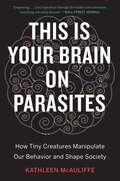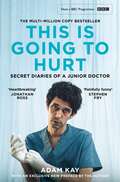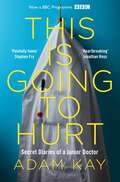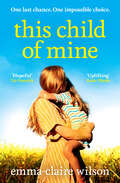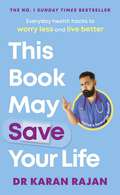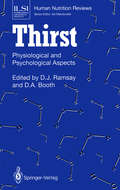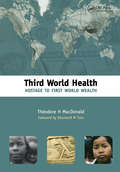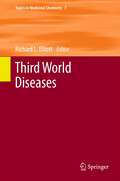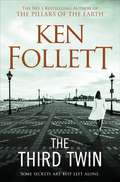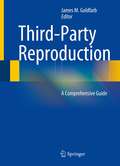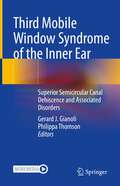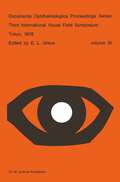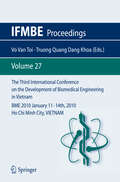- Table View
- List View
This Won't Hurt a Bit: (And Other White Lies): My Education in Medicine and Motherhood
by Michelle AuMichelle Au started medical school armed only with a surfeit of idealism, a handful of old ER episodes for reference, and some vague notion about "helping people."This Won't Hurt a Bit is the story of how she grew up and became a real doctor.It's a no-holds-barred account of what a modern medical education feels like, from the grim to the ridiculous, from the heartwarming to the obscene. Unlike most medical memoirs, however, this one details the author's struggles to maintain a life outside of the hospital, in the small amount of free time she had to live it. And, after she and her husband have a baby early in both their medical residencies, Au explores the demands of being a parent with those of a physician, two all-consuming jobs in which the lives of others are very literally in her hands.Au's stories range from hilarious to heartbreaking and hit every note in between, proving more than anything that the creation of a new doctor (and a new parent) is far messier, far more uncertain, and far more gratifying than one could ever expect.
This Won't Hurt: How Medicine Fails Women
by Marieke Bigg'A vital subject that needs to be discussed -KATY HESSEL, AUTHOR OF THE STORY OF ART WITHOUT MEN'A valuable sociological perspective on women's bodies and health and an even more valuable (and optimistic) view of a better future for all.' GINA RIPPON'Asking all the right questions about the treatment of women's bodies and more importantly, answering them. Punchy, fascinating and vital.' RACHEL PARRIS'A brilliant book.' HELEN PANKHURSTThe idea that medicine is gender-neutral is a myth. This isn't inflammatory rhetoric; it's simply true. From the way pain is felt, to how heart attacks are diagnosed, to the very role society plays in the health of the body, the medical landscape in place today is one that was designed for, and by, men. This book is about all the ways medicine is not gender-neutral, from research to treatment to diagnosis. Throughout history, flawed mindsets have paved the way for sub-par treatment, and the prevailing attitudes that still exist today have had terrible repercussions for women and their bodies. Blending fascinating examples with historical and cultural context, and reflecting on her own personal experience with healthcare, Dr Marieke Bigg explores how women's bodies have been ignored, misunderstood and misdiagnosed, whilst keeping an eye to a better future. This is a sharp and honest must-read, and an empowering tool for anyone committed to making this world safer to navigate for all.
This Mortal Coil: A History of Death
by Andrew Doig'In this gripping book, Andrew Doig explores the fascinating biology of our own mortality and, crucially, what death can teach us about life' Prof. Lewis Dartnell, author of Origins: How the Earth Shaped Human HistoryCauses of death have changed irrevocably across time. In the course of a few centuries we have gone from a world where disease or violence were likely to strike anyone at any age, and where famine could be just one bad harvest away, to one where in many countries excess food is more of a problem than a lack of it. Why have the reasons we die changed so much? How is it that a century ago people died mainly from infectious disease, while today the leading causes of death in industrialised nations are heart disease and stroke? And what do changing causes of death reveal about how previous generations have lived? University of Manchester Professor Andrew Doig provides an eye-opening portrait of death throughout history, looking at particular causes – from infectious disease to genetic disease, violence to diet – who they affected, and the people who made it possible to overcome them. Along the way we hear about the long and torturous story of the discovery of vitamin C and its role in preventing scurvy; the Irish immigrant who opened the first washhouse for the poor of Liverpool, and in so doing educated the public on the importance of cleanliness in combating disease; and the Church of England curate who, finding his new church equipped with a telephone, started the Samaritans to assist those in emotional distress. This Mortal Coil is a thrilling story of growing medical knowledge and social organisation, of achievement and, looking to the future, of promise.
This Mortal Coil: A History of Death
by Andrew Doig'In this gripping book, Andrew Doig explores the fascinating biology of our own mortality and, crucially, what death can teach us about life' Prof. Lewis Dartnell, author of Origins: How the Earth Shaped Human HistoryCauses of death have changed irrevocably across time. In the course of a few centuries we have gone from a world where disease or violence were likely to strike anyone at any age, and where famine could be just one bad harvest away, to one where in many countries excess food is more of a problem than a lack of it. Why have the reasons we die changed so much? How is it that a century ago people died mainly from infectious disease, while today the leading causes of death in industrialised nations are heart disease and stroke? And what do changing causes of death reveal about how previous generations have lived? University of Manchester Professor Andrew Doig provides an eye-opening portrait of death throughout history, looking at particular causes – from infectious disease to genetic disease, violence to diet – who they affected, and the people who made it possible to overcome them. Along the way we hear about the long and torturous story of the discovery of vitamin C and its role in preventing scurvy; the Irish immigrant who opened the first washhouse for the poor of Liverpool, and in so doing educated the public on the importance of cleanliness in combating disease; and the Church of England curate who, finding his new church equipped with a telephone, started the Samaritans to assist those in emotional distress. This Mortal Coil is a thrilling story of growing medical knowledge and social organisation, of achievement and, looking to the future, of promise.
This Is Your Brain On Parasites: How Tiny Creatures Manipulate Our Behavior And Shape Society
by Kathleen McAuliffe"Engrossing … [An] expedition through the hidden and sometimes horrifying microbial domain." -Wall Street Journal "Fascinating-and full of the kind of factoids you can't wait to share." -Scientific American Parasites can live only inside another animal and, as Kathleen McAuliffe reveals, these tiny organisms have many evolutionary motives for manipulating the behavior of their hosts. With astonishing precision, parasites can coax rats to approach cats, spiders to transform the patterns of their webs, and fish to draw the attention of birds that then swoop down to feast on them. We humans are hardly immune to their influence. Organisms we pick up from our own pets are strongly suspected of changing our personality traits and contributing to recklessness and impulsivity-even suicide. Germs that cause colds and the flu may alter our behavior even before symptoms become apparent. Parasites influence our species on the cultural level, too. Drawing on a huge body of research, McAuliffe argues that our dread of contamination is an evolved defense against parasites. The horror and revulsion we are programmed to feel when we come in contact with people who appear diseased or dirty helped pave the way for civilization, but may also be the basis for major divisions in societies that persist to this day. This Is Your Brain on Parasites is both a journey into cutting-edge science and a revelatory examination of what it means to be human.
This is Our Brain
by Jeroen HendrikseAlthough many things can go wrong in the brain, this book also shows that our brain is strong. It highlights the key findings that can be seen on magnetic resonance imaging (MRI) and computed tomography (CT) scans, including those related to normal brain aging and common diseases such as brain infarcts, fractures of the skull as well as fractures and tumors of the vertebral column. It offers insights into brain MRI and CT scans, enabling readers to interpret the key findings.
This is Going to Hurt: Now a major BBC comedy-drama
by Adam KayNow a major new BBC comedy-drama starring BAFTA and Emmy award-winning actor Ben WhishawThe multi-million copy bestseller now with an exclusive new preface by the authorWelcome to the life of a junior doctor: 97-hour weeks, life and death decisions, a constant tsunami of bodily fluids, and the hospital parking meter earns more than you.Scribbled in secret after endless days, sleepless nights and missed weekends, Adam Kay's This is Going to Hurt provides a no-holds-barred account of his time on the NHS front line. Hilarious, horrifying and heartbreaking, this diary is everything you wanted to know – and more than a few things you didn't – about life on and off the hospital ward.Sunday Times Number One Bestseller for over a year and winner of a record FOUR National Book Awards: Book of the Year, Non-Fiction Book of the Year, New Writer of the Year and Zoe Ball Book Club Book of the Year.
This is Going to Hurt: Now a major BBC comedy-drama
by Adam KayA Major BBC Series Starring Ben Whishaw. The multi-million copy bestseller and Book of the Year at The National Book Awards.‘Painfully funny. The pain and the funniness somehow add up to something entirely good, entirely noble and entirely loveable.' - Stephen FryWelcome to the life of a junior doctor: 97-hour weeks, life and death decisions, a constant tsunami of bodily fluids, and the hospital parking meter earns more than you.Scribbled in secret after endless days, sleepless nights and missed weekends, Adam Kay's This is Going to Hurt provides a no-holds-barred account of his time on the NHS front line. Hilarious, horrifying and heartbreaking, this diary is everything you wanted to know – and more than a few things you didn't – about life on and off the hospital ward.Sunday Times Number One Bestseller for over eight months and winner of a record FOUR National Book Awards: Book of the Year, Non-Fiction Book of the Year, New Writer of the Year and Zoe Ball Book Club Book of the Year.This edition includes extra diary entries and an afterword by the author.
This Is Bioethics: An Introduction (This Is Philosophy Ser.)
by Ruth F. Chadwick Udo SchuklenkShould editing the human genome be allowed? What are the ethical implications of social restrictions during a pandemic? Is it ethical to use animals in clinical research? Is prioritizing COVID-19 treatment increasing deaths from other causes? Bioethics is a dynamic field of inquiry that draws on interdisciplinary expertise and methodology to address normative issues in healthcare, medicine, biomedical research, biotechnology, public health, and the environment. This Is Bioethics is an ideal introductory textbook for students new to the field, exploring the fundamental questions, concepts, and issues within this rapidly evolving area of study. Assuming no prior knowledge of the subject, this accessible volume helps students consider both traditional and cutting-edge questions, develop informed and defensible answers, and evaluate the strengths and weaknesses of a diverse range of ethical positions in medicine. The authors avoid complex technical terms and jargon in favor of an easy-to-follow, informal writing style with engaging chapters designed to stimulate student interest and encourage class discussion. The book also features a deep dive into the realm of global public health ethics, including the response to the COVID-19 pandemic. It considers topics like triage decision-making, the proportionality of society's response to COVID-19, whether doctors have a professional obligation to treat COVID-19 patients, and whether vaccines for this virus should be mandatory. A timely addition to the acclaimed This Is Philosophy series, This Is Bioethics is the ideal primary textbook for undergraduate bioethics and practical ethics courses, and is a must-have reference for students in philosophy, biology, biochemistry, and medicine.
This Is Bioethics: An Introduction (This Is Philosophy Ser.)
by Ruth F. Chadwick Udo SchuklenkShould editing the human genome be allowed? What are the ethical implications of social restrictions during a pandemic? Is it ethical to use animals in clinical research? Is prioritizing COVID-19 treatment increasing deaths from other causes? Bioethics is a dynamic field of inquiry that draws on interdisciplinary expertise and methodology to address normative issues in healthcare, medicine, biomedical research, biotechnology, public health, and the environment. This Is Bioethics is an ideal introductory textbook for students new to the field, exploring the fundamental questions, concepts, and issues within this rapidly evolving area of study. Assuming no prior knowledge of the subject, this accessible volume helps students consider both traditional and cutting-edge questions, develop informed and defensible answers, and evaluate the strengths and weaknesses of a diverse range of ethical positions in medicine. The authors avoid complex technical terms and jargon in favor of an easy-to-follow, informal writing style with engaging chapters designed to stimulate student interest and encourage class discussion. The book also features a deep dive into the realm of global public health ethics, including the response to the COVID-19 pandemic. It considers topics like triage decision-making, the proportionality of society's response to COVID-19, whether doctors have a professional obligation to treat COVID-19 patients, and whether vaccines for this virus should be mandatory. A timely addition to the acclaimed This Is Philosophy series, This Is Bioethics is the ideal primary textbook for undergraduate bioethics and practical ethics courses, and is a must-have reference for students in philosophy, biology, biochemistry, and medicine.
This Common Secret: My Journey as an Abortion Doctor
by Susan Wicklund Alan KesselheimA brave account of the social and political forces that threaten a woman's right to choose, this emotionally affecting memoir from a doctor on the front lines of the abortion debate reveals what's really at stake in the Supreme CourtIn America the reproductive justice debate is reaching a new pitch, with the Supreme Court weighted against women's choice and state legislatures passing bills to essentially outlaw the practice of abortion. With This Common Secret, Dr. Susan Wicklund chronicles her twenty-year career in the vanguard of the abortion war. Growing up in working-class rural Wisconsin, Susan made the painful decision to have an abortion at a young age. It was not until she became a doctor that she realized how many women shared her ordeal of an unwanted pregnancy...and how hidden this common experience remains.Now, in this raw and riveting true story, Susan and the patients she's treated share the complex, anguished, and empowering emotions that drove their own choices. Hers is a calling that means sleeping on planes and commuting between clinics in different states--and that requires her to wear a bulletproof vest and to carry a .38 caliber revolver. This Common Secret reveals the truth about the reproductive health clinics that anti-abortion activists mischaracterize as damaging and unsafe. This intimate memoir explains how social stigma and restrictive legislation can isolate women who are facing difficult personal choices--and how we as a nation can, and must, support them.
This Common Secret: My Journey as an Abortion Doctor
by Susan Wicklund Alan KesselheimA brave account of the social and political forces that threaten a woman's right to choose, this emotionally affecting memoir from a doctor on the front lines of the abortion debate reveals what's really at stake in the Supreme Court In America the reproductive justice debate is reaching a new pitch, with the Supreme Court weighted against women's choice and state legislatures passing bills to essentially outlaw the practice of abortion. With This Common Secret, Dr. Susan Wicklund chronicles her twenty-year career in the vanguard of the abortion war. Growing up in working-class rural Wisconsin, Susan made the painful decision to have an abortion at a young age. It was not until she became a doctor that she realized how many women shared her ordeal of an unwanted pregnancy. . . and how hidden this common experience remains. Now, in this raw and riveting true story, Susan and the patients she's treated share the complex, anguished, and empowering emotions that drove their own choices. Hers is a calling that means sleeping on planes and commuting between clinics in different states -- and that requires her to wear a bulletproof vest and to carry a .38 caliber revolver. This Common Secret reveals the truth about the reproductive health clinics that anti-abortion activists mischaracterize as damaging and unsafe. This intimate memoir explains how social stigma and restrictive legislation can isolate women who are facing difficult personal choices -- and how we as a nation can, and must, support them.
This Child of Mine
by null Emma-Claire Wilson‘Beautiful, emotional and hopeful, but have tissues to hand.’ Liz Fenwick When Stephanie is told she’s pregnant and that she is sick on the same day, she faces an impossible choice… After trying for a baby for so long, finding out I was pregnant was supposed to be the happiest day of my life. But in the same breath as the news I had been waiting years to hear, the doctor told me I was seriously ill. If I carry my baby to term, I will almost certainly die. If I proceed with treatment, my baby will not live. My husband – the father of this child – is telling me to save myself. But with all the secrets I know he is keeping from me, I can’t trust him anymore. What would you do? An emotional yet uplifting tear-jerker that will have you reaching for the tissues – perfect for fans of EMMA ROBINSON and JODI PICOULT. This Child of Mine is breaking reader’s hearts! ‘The ultimate decision! What a heartbreaking story.’ Real Reader Review, ⭐⭐⭐⭐ ‘WOW. What a heartbreaking, but beautifully written story, I absolutely loved every minute of this book – and what an ending!’ Real Reader Review, ⭐⭐⭐⭐⭐ ‘This book certainly proves that when you want to be a mother, you will do everything possible to get it. Beautifully written.’ Real Reader Review, ⭐⭐⭐⭐ ‘This Child of Mine will give you all of the feels. This beautifully written story will have you reaching for the tissues.’ Real Reader Review, ⭐⭐⭐⭐
This Book May Save Your Life: Everyday Health Hacks to Worry Less and Live Better
by Dr Karan RajanTHE #1 SUNDAY TIMES BESTSELLER'When you want to sort medical fact from medical fiction, Dr Karan is your man. This is the only book that will have you laughing and learning in equal measure' Dr Julie Smith, bestselling author of Why Has Nobody Told Me This Before'In a world of charlatans and social media snake-oil salesmen, [Dr Karan] provides a voice of reason...his health hacks may save your life' Mail on Sunday_______________________________The hilarious, myth-busting survival guide to the human body from TikTok's favourite General Surgeon.Though the odds are stacked against us, the human body has an extraordinary tendency to survive...Full of hard-learned lessons and health hacks from Dr Karan Rajan's years working the hospital wards, This Book May Save Your Life is a head-to-toe ode to our amazing bodies - warts and all - that will help you to worry less and live better for longer.Here, Dr Karan explains the weird and wonderful bodily functions that keep us going, and offers practical advice to help you thrive when things go wrong, including:THE DANGERS OF PLUCKING YOUR NOSE HAIRSYOUR UNTAPPED NATURAL REFLEXES TO COMBAT STRESSHOW TO MANAGE PAIN WITH SIMPLE MIND TRICKSAND WHY YOU SHOULD NEVER HOLD IN A FART_______________________________'I'll never look at my anus the same way' Hayley Morris, bestselling author of Me Vs Brain_______________________________PRAISE FOR DR KARAN RAJAN'The go-to expert for a generation' Telegraph'One of the few reliable social media experts' Daily Mail
This Book is Worth €25,000: Easy ways to save thousands of euro right now
by Karl Deeter Charlie WestonSo much of what we hear about personal finance is confusing and time-consuming but here Ireland’s leading personal finance experts have made it as simple as possible to help you save up to €25,000. Charlie Weston and Karl Deeter see every day how too many of us pay over the odds, get ripped off or simply don’t maximise the money we have. Here they share the financial hacks and money-saving tips and tricks they have picked up through years of working as personal finance experts. Each chapter covers a single common personal finance topic, explaining how you can make better choices in this area, the amount you can expect to save over a year, the time it will take to follow the tip and a star rating for the complexity or hassle factor.
Thirty Years CINP: A Brief History of the Collegium Internationale Neuro-Psychopharmacologicum
by Thomas A. Ban and Hanns HippiusThe development of modern psychopharmacology was triggered by two major discoveries: the psychomimetic effects of lysergic acid diethylamide (LSD-25) in 1943 and the therapeutic effects of chlorpromazine in 1952. In his opening address to the 1st CINP Congress in Rome, Rothlin pointed out that these discoveries gave "a great impetus for any kind of scientific approach to brain research" and had "revolutionary consequences in the treatment of psychotic patients". The incentive they provided "was not limited to theoretical and practical medical sciences but caused an even greater stimulus to the imagination of chemists, leading to the production of new compounds with a speed that neither pharmacological, biochemical nor clinical investigations could equitably follow. " The possibility to induce psychopathology by the administration of pharmacological agents and to control naturally occurring psychopathol ogy by drugs opened unforeseen possibilities for brain research and a new era in psychiatry. In psychiatry, the new psychotropic drugs with their increasingly better defined behavioral, neurophysiological and biochemi cal actions have provided a new means for therapeutically influencing and systematically studying psychopathological conditions, whereas in the basic sciences, neuropharmacological research, directed to reveal the action mechanism of new drugs, brought about unprecedented progress in the identification of the morphological substrate of different brain func tions. It also set the stage for the exploration of possible correlations between behavioral, including psychopathological, and neurochemical events.
Thirst: Physiological and Psychological Aspects (ILSI Human Nutrition Reviews)
by David J. Ramsay David BoothAt one time or another, everyone has said "I am thirsty". Yet what causes this sensation of thirst? It is obvious that a certain quantity of fluid must be present for the body to function normally. How does a water deficit in the body then influence drinking habits? But supposing the physiological need is met, what about the psychological need or social need? Water is certainly the most necessary fluid; then why do we humans often prefer other beverages, even at great cost of effort or money or health? The subject of thirst and drinking behavior are uniquely discussed in this book. For the first time both the physiological and the psychological aspects of water and beverage consumption are examined in one volume. The many recent developments concerning how a lack of water is signalled physiologically and processed neurally to affect drinking behavior are critically surveyed. Prospects for understanding the cultural and sensory influences on beverage consumption are mapped out. The thirty-one chapters by authorities in the field were all mutually reviewed and revised in the light of precirculated comments and round-table discussions. Together they provide a complete picture of the current state of knowledge on what determines fluid consumption in human beings and animals.
Third World Health: Hostage to First World Wealth
by Theodore MacDonaldGreat and increasing inequities exist between the peoples of the Third World and those of the First. As well, we find ourselves threatened by imminent environmental catastrophes largely as a result of trying to maintain such inequities. This clear and straightforward text explains the complex origins of such bodies as the International Monetary Fund, the World Bank and others, and demonstrates the extent to which they exacerbate the problem. The situation is now so grave that we can no longer afford the luxury of leaving it to the professionals. We are all involved. We find ourselves hearing daily news reports of wars, starvation, the HIV/AIDS pandemic and natural disasters, rendered worse by inadequate international responses. The United Nations, once seen as an effective arbiter and mediator in such matters, now finds itself unable to exercise authority adequately. Third World Health: hostage to First World Wealth adopts a positive approach and puts forward various ways in which people at all levels can become more involved. It addresses the pivotal issue of health in the Third World and argues that it is very much hostage to the globalization of trade by and for the benefit of First World agencies.
Third World Health: Hostage to First World Wealth
by Theodore MacDonaldGreat and increasing inequities exist between the peoples of the Third World and those of the First. As well, we find ourselves threatened by imminent environmental catastrophes largely as a result of trying to maintain such inequities. This clear and straightforward text explains the complex origins of such bodies as the International Monetary Fund, the World Bank and others, and demonstrates the extent to which they exacerbate the problem. The situation is now so grave that we can no longer afford the luxury of leaving it to the professionals. We are all involved. We find ourselves hearing daily news reports of wars, starvation, the HIV/AIDS pandemic and natural disasters, rendered worse by inadequate international responses. The United Nations, once seen as an effective arbiter and mediator in such matters, now finds itself unable to exercise authority adequately. Third World Health: hostage to First World Wealth adopts a positive approach and puts forward various ways in which people at all levels can become more involved. It addresses the pivotal issue of health in the Third World and argues that it is very much hostage to the globalization of trade by and for the benefit of First World agencies.
Third World Diseases (Topics in Medicinal Chemistry #7)
by Richard L. ElliottFederico Gomez de las Heras: Overview of Neglected Tropical Diseases Gwendolyn A. Marriner Amit Nayyar, Eugene Uh, Sharon Y. Wong, Tathagata Mukherjee, Laura E. Via , Matthew Carroll, Rachel L. Edwards, Todd D. Gruber, Inhee Choi, Jinwoo Lee, Kriti Arora, Kathleen D. England, Helena I.M. Boshoff, Clifton E. Barry III: The Medicinal Chemistry of Tuberculosis Chemotherapy Jeremy N. Burrows, David Waterson: Discovering New Medicines to Control and Eradicate Malaria Tomas von Geldern, Michael Oscar Harhay, Ivan Scandale, Robert Don: Kinetoplastid Parasites Pei-Yong Shi,, Zheng Yin, Shahul Nilar, Thomas H. Keller: Dengue Drug Discovery Dan Marquess: Recent Advances in Discovery and Development of Medicines for the Treatment of Secretory Diarrhea in the Developing World
The Third Twin: A Novel
by Ken FollettA thrilling, chilling story of hidden evil, The Third Twin is a heart-stopping, spine-tingling story from master of suspense, Ken Follett.An Impossible ResultJeannie Ferrami, a scientific researcher investigating the behaviour of identical twins who have been raised separately, uncovers a perplexing mystery; identical twins who were born on different days, to different mothers, in different places.A Blossoming Love One, Steve, is a law student and the other, Dan, a convicted murderer. As Jeannie works with Steve on her project she finds herself falling in love with him, but their world is shattered when he is accused of a monstrous crime.A Terrible SecretJeannie cannot believe that Steve committed the crime, but proving it means she will be forced to question everything she believes. And as she digs deeper, her investigation uncovers a terrifying conspiracy – and it becomes clear the plotters will kill to keep it hidden.
Third-Party Reproduction: A Comprehensive Guide
by James M. GoldfarbThe first IVF conceived birth in 1978 resulted in a significant growth of third party reproductive options which continue to raise ethical, legal, and psychological questions. Third party reproduction procedures can involve as many as five people: sperm donor, egg donor, gestational carrier, and intended parents. Third-Party Reproduction: A Comprehensive Guide utilizes experts in the field to address the medical, psychological, ethical and legal aspects of sperm donation, egg donation, embryo donation, and the use of gestational carriers. In addition, there are chapters on the medical and ethical aspects of posthumous reproduction, religious aspects of third party reproduction, and how to avoid pitfalls of third party reproduction. Aimed at physicians, trainees, psychologists, nurses, and social workers whose practices may include patients considering third party reproduction, the intent of this book is to provide a comprehensive and practical overview of the many aspects of third party reproduction to help all those involved to better understand them. Patients considering third party reproduction may also find value in this book.
Third Mobile Window Syndrome of the Inner Ear: Superior Semicircular Canal Dehiscence and Associated Disorders
by Gerard J. Gianoli Philippa ThomsonThis book aims to provide a deeper understanding of Third Mobile Window Syndrome and its various forms beyond just Superior Canal Dehiscence. It will illuminate the various presentations of Third Mobile Window Syndrome, provide the means for diagnosis, and elucidate treatments. The disorder Superior Semicircular Canal Dehiscence Syndrome was discovered in 1995 by Dr Lloyd Minor at The John Hopkins University School of Medicine in Baltimore. Though he published his findings in 1998, there remains no book wholly devoted to the topic. For this reason, many neurotologists and otorhinolaryngologists still misunderstand this condition and its presentation. Structured in six parts, the first part will be important in providing a context, and drawing together all of the learning that has been acquired since 1998, as well as explaining the complexities of the condition. The second and third parts will set out to detail all the aspects that are necessary for diagnosing a patient and then deciding on the best form of treatment, surgical or otherwise. Part four covers special situations, including bilateral SCDS and the pediatric patient. In part five, Philippa Thomson, a patient herself, will describe the patient perspective of symptoms and the complicated journey of identifying a diagnosis and securing expert care. Finally, part six covers future research. Third Mobile Window Syndrome of the Inner Ear: Superior Semicircular Canal Dehiscence and Associated Disorders will provide clinicians involved in the treatment of inner ear disorders, balance dysfunction, and dizziness with the expertise they need to assist patients with Third Mobile Window Syndrome. It will also supply useful information to neurotologists/otologists, otolaryngologists, and neurologists. Researchers in the field of inner ear disorders will also find this to be a valuable text.
Third International Visual Field Symposium Tokyo, May 3–6, 1978 (Documenta Ophthalmologica Proceedings Series #19)
by E.L. GreveERIK L. GREVE The 3rd International Visual Field Symposium was held on the 4th till the 6th of May 1978 in Tokyo for the members and guests of the International Perimetric Society. The Proceedings of this symposium follow the general lines of the pro gramme with some minor alterations. This symposium was a so-called topic-symposium where selected topics were introduced by experts in the field. These topics were: Neuro-ophtha[mo[ogy. 1. Funduscopic correlates of visual field defects. 2. Visual field defects due to tumors of the sellar region. Glaucoma. 1. The earliest visual field defects in glaucoma. 2. The reversibility of glaucomatous visual field defects. Methodology. 1. Automation. 2. The relation between the position of a lesion in the fundus and in the visual field. Apart from the introductory papers, free papers were given on the topics non-topic free papers. and also some Much attention has been given to the discussion. Most of the discussion remarks in this Proceedings are the original taped remarks of the discussion speakers. We have choosen this form of presentation to take to the reader the athmosphere of the discussion and to preserve originality. The chairman of the sessions have presented a summary or even better an interpretation of the trends in their topics. This introduction gives a short overview of the main themes of the symposium.
The Third International Conference on the Development of Biomedical Engineering in Vietnam: BME2010January 11 – 14th, 2010Ho Chi Minh City, VIETNAM (IFMBE Proceedings #27)
by Vo Van Toi Truong Quang KhoaVietnam is a rapidly developing, socially dynamic country, where interest in biomedical engineering activities has grown considerably in recent years. The leadership of the Vietnamese government, and of research and educational institutions, are well aware of the importance of this field for the development of the country and have instituted policies to promote its development. The political, economic and social environment within the country offers unique opportunities for the international community and this conference was intended to provide a vehicle for the sharing of experiences; development of support and collaboration networks for research; and exchange of ideas on how to improve the educational and entrepreneurial environment to better address the urgent needs of Vietnam. In January 2004, under the sponsorship of the U.S. National Science Foundation, a U.S. delegation that consisted of Biomedical Engineering professors from different universities in the United States, visited several universities and research institutions in Vietnam to assess the state of development of this field. This delegation proposed a five year plan that was enthusiastically embraced by the international scientific communities to actively develop collaborations with Vietnam. Within this framework, in July 2005, the First International Conference on the Development of Biomedical Engineering in Vietnam was held in Ho Chi Minh City. From that conference a Consortium of Vietnam-International Universities was created to advise and assist the development of Biomedical Engineering in Vietnamese universities.




